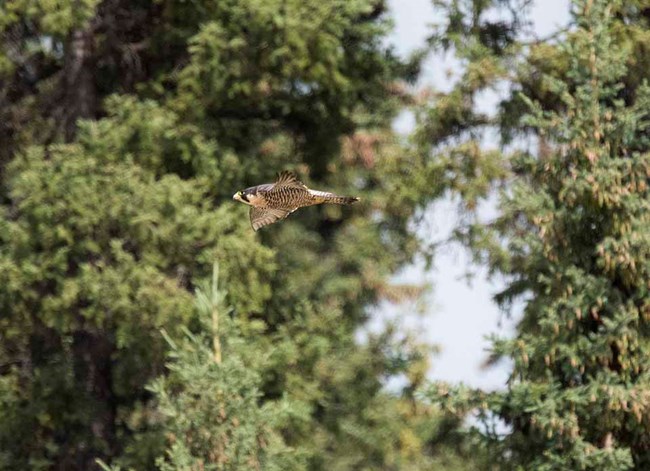
NPS/Sean Tevebaugh
When it comes to monitoring animal species in the Central Alaska Network, we chose species that are spread across the trophic levels of park ecosystems. By doing this we will have a better chance of observing change wherever it may come. We can try to forecast what kinds of change may occur, but it's harder to predict precisely where it will happen, or what form it may take. We chose three raptor species for monitoring across the network. Peregrine Falcons are the raptor species that is monitored in Yukon-Charley National Preserve, while Golden Eagles are monitored in Denali National Park and Preserve, and Bald Eagles are monitored in Wrangell-St. Elias National Park and Preserve. Peregrines are a top-level predator and feed largely on waterfowl and other small birds.
Yukon-Charley Rivers National Preserve was created, in part, because of its population of nesting Peregrine Falcons, making them a high-priority focal species for monitoring. They are also highly sensitive to environmental contaminants and habitat alteration. The population of the upper Yukon River corridor is one of the densest in North America. They have been surveyed each year since 1975 and are one of the longest and most thoroughly studied populations of Peregrine Falcons in the world.
The number of occupied territories has shown a steady increase since the species neared extinction in the early 1970s because of nest failure caused by DDT contamination. Recent evidence suggests that American Peregrine Falcons are still threatened by environmental contaminants. Analyses of Peregrine eggs from the upper Yukon River suggest that mercury levels are increasing. Mercury is a persistent compound that bioaccumulates at high trophic levels and causes toxic effects (similar to DDT). The amount of mercury found in Yukon River area eggs is currently at levels that may affect reproduction. High levels of mercury are made biologically available through industrial processes such as mining and waste incineration and will likely increase with global industrialization. Additionally, DDT and other pesticides are still being used on Peregrine wintering grounds, which may cause continued risk to the population.
We monitor Peregrine Falcons in Yukon-Charley Rivers National Preserve to:
-
Determine annual levels of nesting territory occupancy, nesting success, and overall population productivity.
-
Determine variation in nesting territory occupancy, nesting success, and productivity during the last decade.
-
Describe historic levels of environmental contaminants and eggshell thickness.
-
Determine levels of organochlorine pesticides, mercury, and eggshell thickness every five years.
-
Measure changes in habitat on the breeding range.
Contact: Melanie Flamme
Last updated: January 30, 2019
